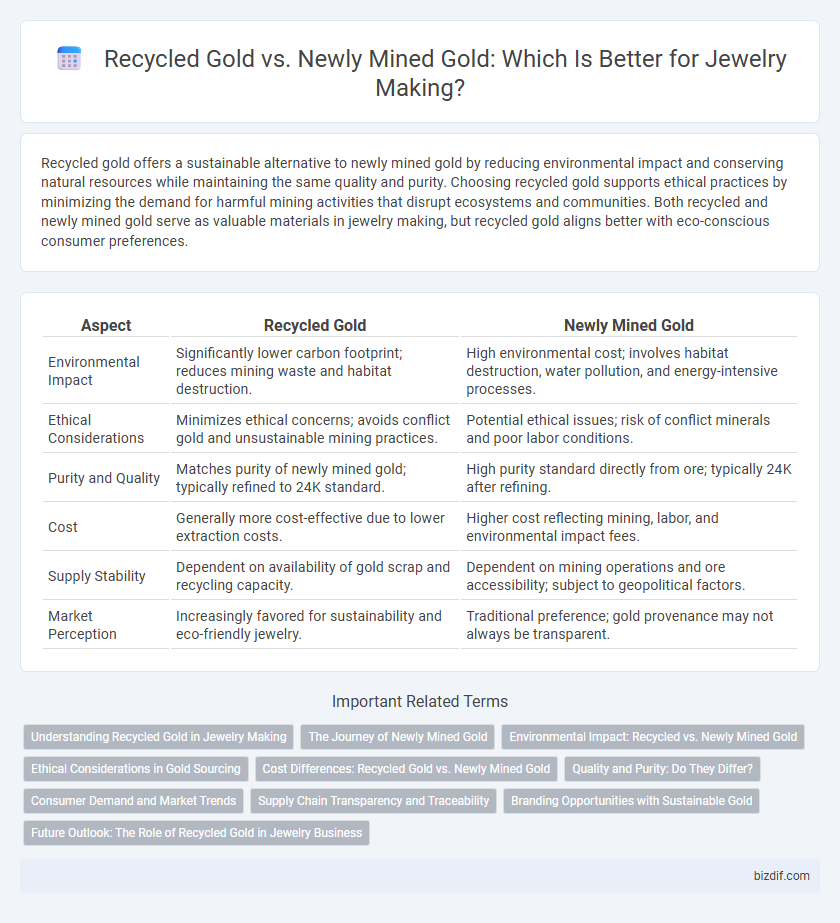Recycled gold offers a sustainable alternative to newly mined gold by reducing environmental impact and conserving natural resources while maintaining the same quality and purity. Choosing recycled gold supports ethical practices by minimizing the demand for harmful mining activities that disrupt ecosystems and communities. Both recycled and newly mined gold serve as valuable materials in jewelry making, but recycled gold aligns better with eco-conscious consumer preferences.
Table of Comparison
| Aspect | Recycled Gold | Newly Mined Gold |
|---|---|---|
| Environmental Impact | Significantly lower carbon footprint; reduces mining waste and habitat destruction. | High environmental cost; involves habitat destruction, water pollution, and energy-intensive processes. |
| Ethical Considerations | Minimizes ethical concerns; avoids conflict gold and unsustainable mining practices. | Potential ethical issues; risk of conflict minerals and poor labor conditions. |
| Purity and Quality | Matches purity of newly mined gold; typically refined to 24K standard. | High purity standard directly from ore; typically 24K after refining. |
| Cost | Generally more cost-effective due to lower extraction costs. | Higher cost reflecting mining, labor, and environmental impact fees. |
| Supply Stability | Dependent on availability of gold scrap and recycling capacity. | Dependent on mining operations and ore accessibility; subject to geopolitical factors. |
| Market Perception | Increasingly favored for sustainability and eco-friendly jewelry. | Traditional preference; gold provenance may not always be transparent. |
Understanding Recycled Gold in Jewelry Making
Recycled gold in jewelry making involves repurposing gold from old or discarded pieces, reducing the environmental impact associated with mining new gold. This sustainable alternative maintains the same purity and quality as newly mined gold while minimizing carbon emissions and land degradation. Choosing recycled gold supports ethical sourcing and promotes a circular economy within the jewelry industry.
The Journey of Newly Mined Gold
Newly mined gold undergoes an extensive journey beginning with extraction from deep underground mines followed by refining to achieve high purity suitable for jewelry making. The refining process removes impurities and enhances quality, often involving complex chemical treatments to ensure the gold meets industry standards. This journey demands significant energy and environmental resources, contrasting sharply with recycled gold, which bypasses the initial extraction phase.
Environmental Impact: Recycled vs. Newly Mined Gold
Recycled gold significantly reduces environmental impact by conserving natural resources and minimizing the ecological damage caused by mining activities such as deforestation, soil erosion, and water contamination. Newly mined gold entails extensive energy consumption, carbon emissions, and habitat destruction, contributing to long-term environmental degradation. Choosing recycled gold supports sustainable practices in the jewelry industry and lowers the overall carbon footprint associated with gold production.
Ethical Considerations in Gold Sourcing
Recycled gold significantly reduces environmental impact by minimizing mining waste and habitat destruction, aligning with ethical sourcing standards in the jewelry industry. Newly mined gold often involves exploitation of labor and contributes to ecological degradation, raising concerns about human rights and sustainability. Choosing recycled gold supports transparent supply chains and promotes responsible consumption, essential for ethical jewelry making.
Cost Differences: Recycled Gold vs. Newly Mined Gold
Recycled gold typically costs less than newly mined gold due to lower extraction and processing expenses, reducing environmental impact and operational complexities. Newly mined gold involves significant costs associated with mining, refining, and regulatory compliance, which elevate its market price. Jewelers opting for recycled gold can achieve cost savings while promoting sustainable practices in the jewelry industry.
Quality and Purity: Do They Differ?
Recycled gold matches newly mined gold in quality and purity since both are refined to 99.5% or higher before use in jewelry making. The refining process removes impurities, ensuring recycled gold maintains the same standard of durability and luster as newly mined gold. Jewelry crafted from recycled gold offers an eco-conscious choice without compromising on the traditional benchmarks of gold quality.
Consumer Demand and Market Trends
Consumer demand for recycled gold in jewelry making has surged due to increasing environmental awareness and ethical considerations, driving a significant shift in market trends. Recycled gold offers a sustainable alternative to newly mined gold, reducing the environmental impact and appealing to eco-conscious buyers. Market data indicates that jewelry brands focusing on recycled gold are gaining competitive advantages by aligning with responsible sourcing and circular economy principles.
Supply Chain Transparency and Traceability
Recycled gold offers superior supply chain transparency and traceability by reducing reliance on environmentally harmful mining practices and utilizing verified sources. Newly mined gold often involves complex, multi-tiered supply chains that increase the risk of unethical labor and environmental issues, making traceability challenging. Emphasizing recycled gold enhances accountability and supports sustainable practices within the jewelry industry.
Branding Opportunities with Sustainable Gold
Recycled gold offers jewelry brands a powerful sustainable narrative that appeals to eco-conscious consumers seeking ethically sourced materials. Leveraging recycled gold enhances brand reputation by reducing environmental impact and promoting circular economy principles, distinguishing products in a competitive market. Emphasizing transparency in sourcing and sustainability certifications further strengthens consumer trust and loyalty.
Future Outlook: The Role of Recycled Gold in Jewelry Business
Recycled gold is poised to play a pivotal role in the future of the jewelry business as sustainability becomes a key consumer demand and environmental regulations tighten globally. The reduced carbon footprint and lower energy consumption associated with recycled gold compared to newly mined gold make it an economically and ecologically viable alternative. Growing investments in refining and traceability technologies further enhance recycled gold's appeal, positioning it as a critical resource for ethical and responsible jewelry production.
Recycled gold vs Newly mined gold Infographic

 bizdif.com
bizdif.com